Many of you will be out watching fireworks Thursday night, and if you’re into photography like me, you’ll probably have a camera along. There are a few tricks to making good fireworks pictures, and now’s a good time to review them.
Great fireworks pictures are like great sunset pictures. In both cases the best photos come when you have more than just the fireworks or sunset. So the first thing to do is try to find a spot that lets you do that. As they say in real estate, “location is everything.” One of the best locations is near water, where you have a chance of getting reflections. Having a lake, pond or river between you and the fireworks can pay off in nice photos. Another option is to find a spot that has a good background, like buildings. A city skyline can make a nice backdrop to fireworks.
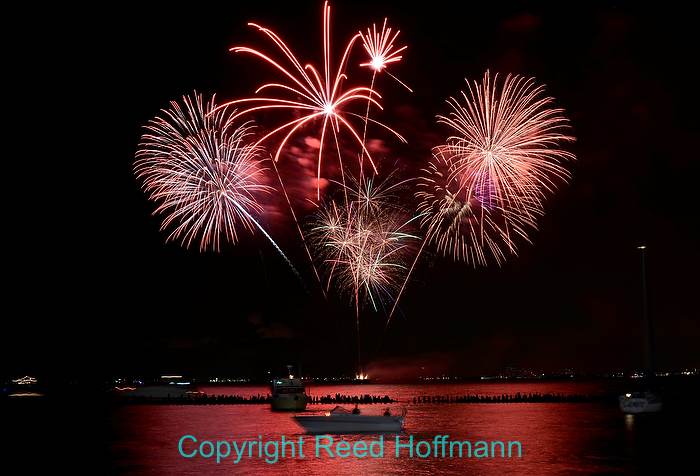
In Chicago they do fireworks near the Navy Pier regularly. Shot on a tripod, this was at ISO 200, six seconds at f/11. Photo copyright Reed Hoffmann.
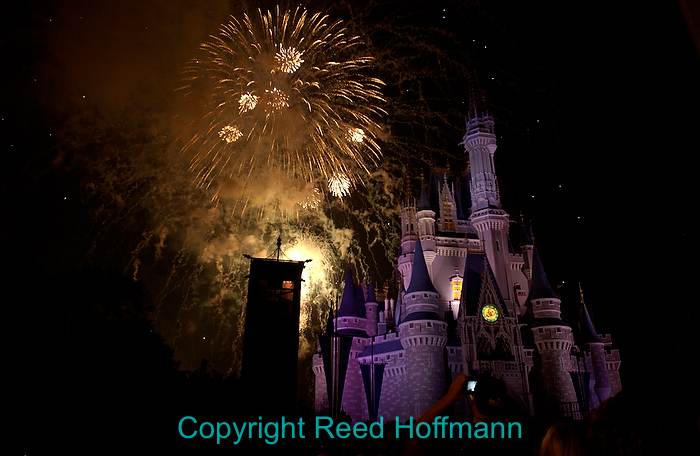
Disneyworld has fireworks every night, and with a castle as a background, it’s hard to miss making a good picture. Without a tripod, I used a faster exposure to avoid blur and made sure the VR switch on my lens was “On.” ISO 400, f/4 at 1/15 second.
Now let’s talk exposure. The most interesting shots are those where you keep the shutter open for a few seconds or more. That lets you capture the streak of the rockets and the burning fireworks as they drift down. Ten seconds is a good starting point. Since the fireworks are very bright, you can use a fairly low ISO. Try starting at 400. And for aperture, try f/8 to begin with. Of course, you’ll need to be in Manual exposure mode to do this. You want to avoid automatic exposure modes, as they’ll be thrown off by the night sky. I always spend the first minute or two of fireworks shows getting my exposure right. I’ll try a shot at the above settings, and if it’s overexposed (too bright), then I can make the aperture smaller (perhaps f/11 or f/16). If it’s too dark, I can open the aperture (maybe f/5.6), or raise the ISO to 800 or 1600. Once I’ve got a good exposure, I can start playing with shorter and longer shutter speeds (from a couple of seconds up to thirty). Longer shutter speeds will capture more bursts, but that can cause overexposure too. Shoot a lot and keep trying different settings.
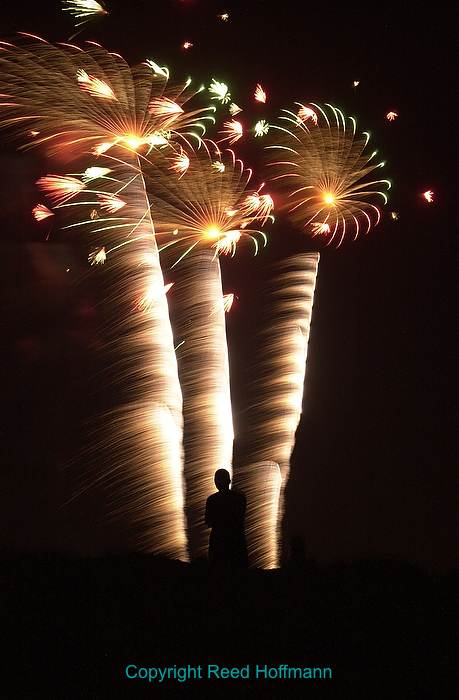
A longer exposure, like this one at ten-seconds, lets you capture multiple rockets and explosions. Photo by Reed Hoffmann.
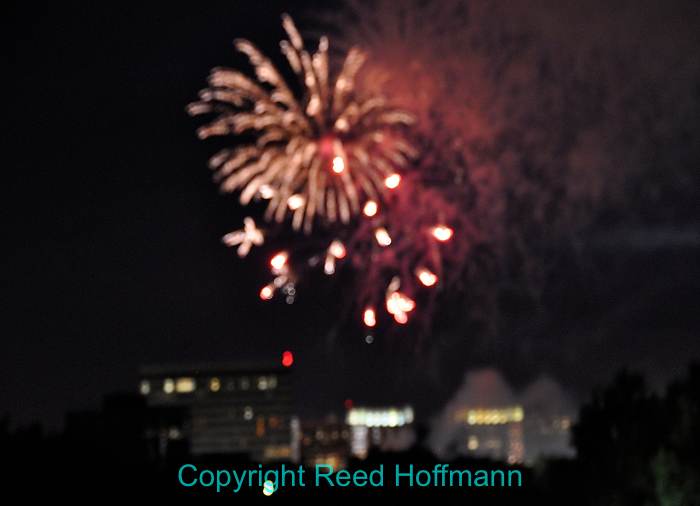
If you don’t turn off autofocus, you’re likely to get pictures that look like this.
Another control you’ll want to change is your autofocus. In dark conditions like this the camera will struggle to find focus. Best idea is to simply turn it off, and focus manually. That’s easy to do, and once you’re focused at the distance the fireworks are, you won’t need to change it.
Set your white balance for whatever else is in the scene. For instance, if I’ve got a city in the background, I’ll use the Incandescent white balance setting. That way the lights in the city will look about right, and it won’t have much effect on the fireworks.
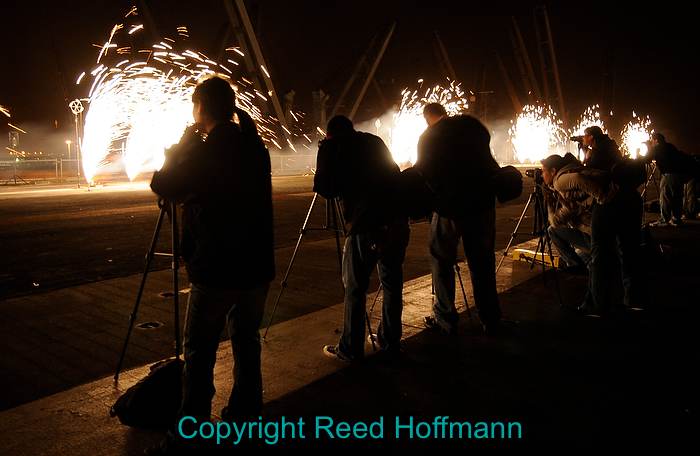
A tripod’s essential if you want to make the best fireworks photos. Photo copyright Reed Hoffmann.
You’re also going to want your camera on a tripod. At long exposures like this you can’t hand-hold the camera. If you don’t have a tripod, set the camera down where it won’t move. I’ve used a camera bag as a makeshift tripod many times.
If you move the camera when pressing the shutter button, you’ll add blur that probably won’t look good. The best way to avoid doing that is to use a cable release, or a remote to fire the camera. If you don’t have one of those, you can use the self-timer, but because of the delay, it’s harder to time your shots as accurately. Most Nikon cameras today let you change the self-timer delay from the default 10-seconds to as little as two-seconds
Finally, remember that in the dark, the LCD will look very bright. If the picture looks good on the back of the camera outside at night, then there’s a good chance it’s underexposed (actually too dark). So don’t let that fool you. If your photos \look a little too bright on the LCD in the dark, odds are they’ll look good later. And if you know how to use the histogram to help judge exposure, by all means use it.
With a little knowledge, it’s easy to make great fireworks pictures. Just be prepared, know how to change your settings, and shoot lots of pictures. And enjoy the fourth of July!
(for regular tips on photography, and links to interesting stories, check out my Facebook page at www.Facebook.com/KCphotographer)

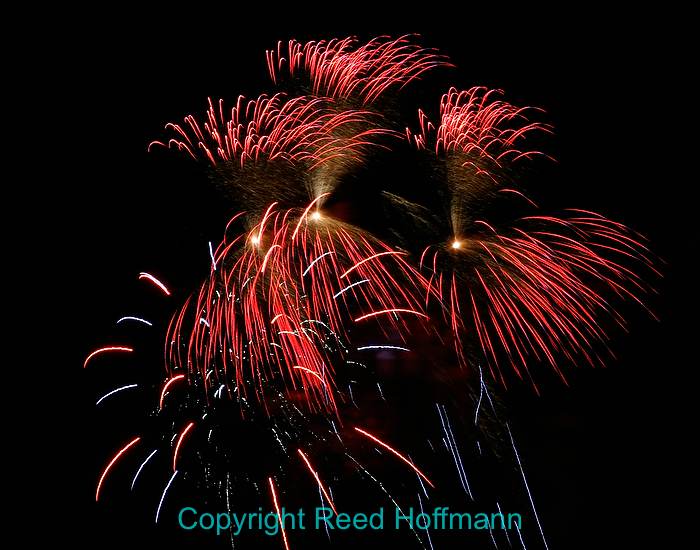
Good advice thanks Reed.
Enjoy the 4th 🇺🇸